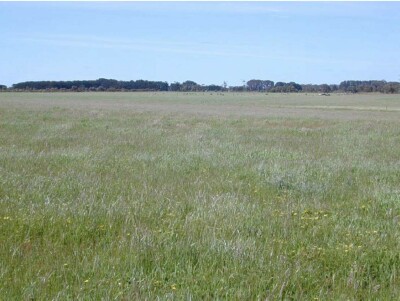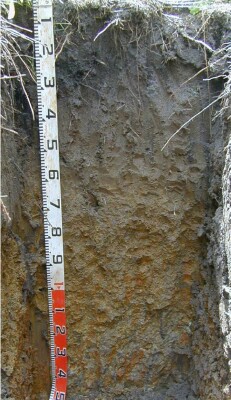WAS98 (Plot 3)
| Site: WAS98 (Plot 3) | Land Unit: Byaduk Basalts |
| Aust. Soil Class.: | |
 | General Land Unit Description: This land unit is a complex unit of steep slopes leading to drainage lines and gently undulating plains leading to the slopes, south east of Branxholme. The soils on the slopes leading to the drainage lines tend to be shallower than those on the plains. The soils on the plains commonly have a sandy topsoil with a bleached A2 horizon over a clay subsoil. A co-dominant soil type is a soil type lacking the sandy topsoil and tends to have a gradual increase in clay (Dermosol) similar to this site. These soils are intermixed with Sodosols. Two year old Eucalyptus globulus plantation on ex-agricultural land |
Site Description:
| Geology: Quaternary basalt | Internal drainage: Imperfectly drained |
| A1 | 0-30 cm | Very dark grey (10YR3/1) loamy sand; single grain structure; very loose consistence when moderately moist; many medium roots; gradual and smooth transition to: |  |
| A21 | 30-62 cm | Dark greyish brown (10YR4/2) sand; single grain structure; very loose consistence when moist; common fine roots; abrupt and smooth transition to: | |
| Subsoil | |||
| B1 | 62-70 cm | Brown (10YR5/3) with many fine faint strong brown (7.5YR5/6) mottles, sandy clay; weak polyhedral structure (20-50 mm); very weak consistence when moist; common very fine macropores; areal porosity 0.3%; common fine roots; gradual and smooth transition to: | |
| B21 | 70-110 cm | Brown (10YR5/3) with many coarse faint strong brown (7.5YR5/6) and red (2.5YR4/6) mottles, medium clay; moderate polyhedral structure (20-50 mm) parting to moderate polyhedral structure (5-10 mm); weak consistence when moist; common fine macropores; areal porosity 0.2%; few very fine roots; diffuse and smooth transition to: | |
| B22 | 110-150 cm | Yellowish brown (10YR7/1) with many very coarse prominent red (2.5YR4/6) mottles, medium clay; strong lenticular structure (20-50 mm) parting to strong polyhedral structure (10-20 mm); weak consistence when moist; few very fine macropores; areal porosity 0.01%; few very fine roots. | |
| 150-250 cm | Similar to layer above. | ||
| 250-400 cm | Weathering, decomposing basalt, remnant roots to 400 cm, very wet, free water seeping in to pit at 400 cm, no impeding layer to root growth. |
Notes: Wetter along cracks in B22 layer, drier in peds, roots follow old root channels and cracks.
Sampled by: Ian Sergeant, Paul Feikema and Martin Clark (31 October 2000)


